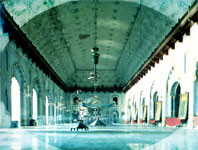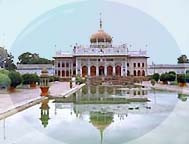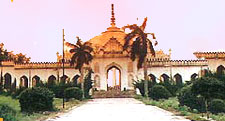|
|

|
|

|
|||||||
|
|
Bara Imambara  (Tomb
of a Muslim holy man)
(Tomb
of a Muslim holy man)
The hall built by Asaf-ud-Daula
for famine relief, is one of the largest in the world. There are excellent
views of Lucknow from the top of the Imambara. An external stairway leads
to an upper floor laid out as an amazing labyrinth known as the
bhulbulaiya.
The dark passages stop abruptly at openings which drop straight to the courtyard
below. There's a mosque with two tall minarets in the courtyard
complex and to the right of this is a
well which is said to have secret tunnels opening into. The Imambara is
open from morning to 6pm.
Rumi Darwaza
This huge 60-feet-high door was also built by Asaf-ud-Daula. It is
also called the 'Turkish Darwaza,' it is the entrance to the Bara Imambara.
It is a massive gate on the the western side of the front of Bara Imambara.
Chota Imambara
Hussainabad or Chota Imambara, was built
by Mohammed Ali Shah in 1837 as his own mausoleum. The appeal of this
structure lies in its furnishings comprising exquisite chandeliers of
Belgium glass. The glittering brass-domes and ornate architecture of this
building made a Russian Prince call it the "Kremlin of India." It contains
the tombs of Ali Shah and his mother. A small bazaar, known as the Gelo
Khana or "Decorated Place", lies inside the imposing entrance of the
Imambara.
The Clock Tower
It is located very near to the Rumi Darwaza. Built in 1881 by
the British, this 67 m-high clock tower on the river Gomti is said to the
tallest clock tower in India. The tower has European style artwork. The
parts of the clock is built of pure gunmetal and the pendulum hangs 14 feet.
The dial of this clock is shaped like a 12-petalled flower and has bells
around it.
Shah Najaf  Imambara
Imambara
It holds the tombs of Ghasi-ud-Din Haidar and his two wife's. Situated on
the south bank of Gomti towards the west of Sikandar Bagh, the building
is almost an exact replica of the tomb of Hazrat Ali, the son-in-law of
Prophet Muhammad, at Najaf Ashraf in Iraq. The interior is used to store
chandeliers, and elaborate creations of wood, bamboo and silver paper which
are carried through the streets during the Muharram Festival. It is open
from 6am to 5pm.
Residency
Built in 1800 by Saadat Ali Khan for the British Resident. There is a model
room in the main Residency building which is worth visiting and a
small museum on the ground floor. This group of buildings became the stage
for the most dramatic events of the 1857 Mutiny the Siege of Lucknow. There
is cemetery near by with graves of those who suffered in the mutiny.
The Residency is open from 9am to 5.30pm.
Noor Baksh
Noor Baksh Kothi (Light giving palace) is in Lal Bagh area next to the Methodist
Church and now known as Noor Manzil. It was believed to be built by
Saadat Ali Khan as a school for royal children while others say Agha Mir,
the Prime Minister was its owner. Rafi us Shan, son of Muhammad Ali Shah
made this his residence till the end of Nawabi rule. Now it houses a psychiatric
clinic for the mentally disturbed.
Chattar Manzil
The two Chattar Manzils near the Begum Hazarat Mahal park, on the banks
of the Gomti were Royal pavilions. The name comes from the gilt chattars
or umbrellas atop the two main buildings. The Greater Chattar Manzil was
once a king's palace. Under the existing river terrace was the ground floor
with the tykhanas (cool underground rooms), cooled by the waters of the
Gomti which lapped against its outer walls. Considering their size, surprisingly
little is known about the Chattar Manzil Palaces. Today this building houses
the Central Medicine Research body. The Lal Baradari was also the part of
Chattar Manzil and was built as Coronation Hall and Durbar Hall.
State Museum
The state Museum in Banarasi Bagh houses an impressive collection of
stone sculptures, 1st-11th century exhibits of Hindu, Buddhist and Jain
works, rare coins, marble sculptures and an Egyptian Mummy. Open 10.30am
to 4.30 pm except Mondays.
Dudhwa
National Park
Dudhwa is 238 km N of Lucknow and was designated a National Park in 1977.
Bordering the Sarda River in the Terai, it is very similar to the Corbett
National Park. It has sal forest, tall savannah grasslands and large marshy
areas watered by the Neora and Sohel rivers. Dudhwa National Park is home
to unusual animal species. This national park's star attraction is the
Royal Bengal tiger. About 100 tigers are believed to still roam this region.
The Indian rhino was also introduced here to save it from extinction.
Leopards, elephants, bears, gharial, crocodile, and spotted deer inhabit
the thick forests too.
Gautam Buddha Park - Situated in between the Bara Imambara and the Martyrs Memorial, this park has been a recreation ground for children. Rides here are a big draw. Also used by political parties to hold rallies now.
The Elephant or the Hathi Park, another recreation park.
The lemon park or the Nimbu Park of the Bara Imambara is also very popular.
Zoo
4 km from the Charbagh station is the Lucknow Zoo or the Prince of Wales
Zoological Gardens. The zoo comes under the Banarasi Bagh area. This Zoo,
constructed in 1921, also has a museum, an aquarium and a toy train. The
plane Rajhans used by Pandit Jawarharlal Nehru is also kept in the zoo.
Open 8am to 5pm.